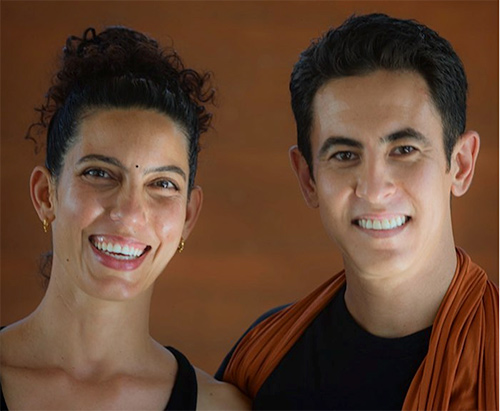
Jiva Massaguer and Daniel Tsukayama, Founders, Sarga Bodywork
The following blog post is sponsored by Sarga Bodywork.
How did Sarga Bodywork get its start?
Sarga Bodywork was developed in Hawaii and grew from our love for barefoot massage, myofascial bodywork, and a desire to make barefoot bodywork more mobile. The curriculum and equipment we use in our courses today are the result of countless hours of research and development—and hundreds of refinements to our equipment designs that began in 2012. At the heart of Sarga Bodywork is our passion for the healing arts and a desire to share our enthusiasm for this transformative work with others.
What are the benefits of training in Sarga Bodywork?
Therapists who train in Sarga Bodywork acquire skills in both barefoot massage and myofascial massage techniques. In truest form, these manual therapy techniques are inseparable from our proprietary equipment. Sarga Bodywork equipment, which is comprised of a fabric strap and the necessary hardware to fasten it to a massage table, enables practitioners to gain tensional support and force by pulling up on the strap while applying downward pressure. In addition, the Sarga Strap can be transformed into a variety of tools and facilitates a wide range of body mechanics for practitioners.
Sarga Bodywork’s mobility is also a major perk for therapists who train with us, and we have equipment for both a raised table and a floor-based configuration that therapists can choose from. Many barefoot and ashiatsu techniques require that overhead bars be installed into the ceiling of a treatment room. Since this is not always possible or desired (and since massage therapists tend to be an independent, mobile demographic), this freedom can be a key benefit of training in Sarga Bodywork.
What sort of therapist should take your classes? Is there a minimum experience level or amount of training a therapist should have before taking your course?
We celebrate the diversity of therapists who attend Sarga Bodywork courses, and whether one is still a novice bodyworker or has 10+ years of barefoot massage experience, cultivating a “beginners mind” is a therapist’s best asset when preparing for a Sarga Bodywork course.
Previous barefoot massage and/or ashiatsu experience is usually an advantage when learning Sarga Bodywork. However, if an MT expects prior experience to translate into an effortless mastery of Sarga Bodywork, they can be sure to prepare for some frustration and disappointment!
The body mechanics employed in barefoot bodywork practices are a world unto itself, and the body mechanics required for Sarga Bodywork are considerably different than those employed in an ashiatsu practice. When compared to the body mechanics used in an ashiatsu practice, a practitioner’s stability is gained from tensional force by pulling upward on a fabric strap. This is almost completely opposite from gaining stability by grasping onto fixed overhead bars.
As a student of Sarga Bodywork, it is in a therapist’s best interest to cultivate an attitude of Shoshin, which is a word from Zen Buddhism meaning "beginner’s mind," and refers to having an attitude of openness, eagerness, and lack of preconceptions when studying a subject—even when studying at an advanced level, just as a beginner would (paraphrased from Wikipedia).
We do ask that therapists who apply for our courses have at least one year of manual therapy experience and can meet our four fitness measurements. These fitness measurements can be found on our website, under “Come to Class Prepared,” at www.sargabodywork.com/come-to-class-prepared.html.
Are your training courses in person, online, or a combination of both?
Currently all our curriculum is taught exclusively in live, in-person courses. Our raised-table courses (Sarga Table 1 & 2) will remain live courses, since we require that students undergo in-person training for proper safety, setup, and use of Sarga Bodywork’s raised-table equipment. However, we receive many requests for online courses, and we do have plans to make some of our floor-based curriculum available as a digital course in the future.
What sets Sarga Bodywork apart from other bodywork modalities?
The use of tensional and gravitational force to deliver barefoot myofascial massage techniques makes Sarga Bodywork a uniquely powerful bodywork modality. As a therapeutic tool, a well-trained bare foot is a dynamic powerhouse. It is not only nimble, sensitive, and dexterous, but provides a strong, broad, and steady contact that is undeniably effective. Barefoot massage is nothing new, but when combined with Sarga Bodywork’s equipment and our unique myofascial methodology, a truly creative and transformative therapy is born.
To see Sarga Bodywork’s nationwide 2020 course calendar, go to www.sargabodywork.com.